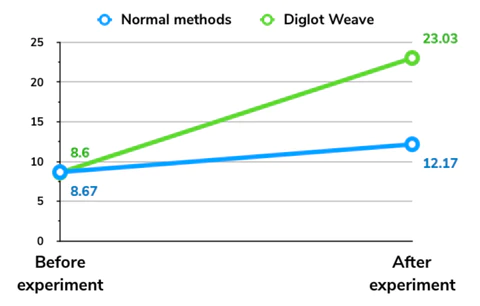What is the Diglot Weave Method?
In this article, we will discuss what is the diglot weave, where it can be used, what are its benefits and why it will be the cornerstone of language-learning into the future. This article originally appeared on weeve.
Definition of the Diglot Weave
Diglot comes from the Greek root words of “di” (meaning “two”) and “glossia” (meaning “tongues”). The process involves weaving or mixing two languages together. In the case of language learning, it is where sentences written in the learner’s native language have words from the language they want to learn mixed in.
Where did the Diglot Weave come from?
It came from “outlandish” research done in the late 60’s by a professor called Robbins Burling. He found it to be faster and easier than any method he had used previously. And, this has continued to be the conclusions from studies done over the next 50 years to this date. Let’s look at one of these studies.
Weaving English into Farsi
A recent study from Nemati in 2014 on English-language learning through Farsi shows that the Diglot Weave method was nearly 100% more effective than traditional language learning methods in the classroom for learning new vocabulary.

How Does the Diglot Weave Method Work?
Our brains crave novelty and we all know we remember more when the context is novel. That is what the Diglot weave method exploits: it presents new words to you in novel context. You don’t have to read boring kids’ stories to learn the simple words in a new language, now you can read the content you want and still pick up words. By seeing the words again and again weaved into the sentences, your brain fills in the gap and begins to associate the foreign word with the meaning of the word that it was subbed in for in your native language.
As context is key, here is an example:
I want to live en Spain after I graduate.
En Spain, there are beautiful beaches and great food.
Where en the world would you like to live?
What does the bolded word mean?
Simple, right? “En” means “in”. There’s your first word in Spanish! And when you consider that your reading ability in a language is the best predictor of your speaking ability, the diglot weave method seems like a no-brainer. But why haven’t we seen it in classrooms so far?
Translating Languages is Hard
There are a few reasons why the Diglot Weave method hasn’t become mainstream in language education up until now.
It is primarily a result of one problem: translating languages is hard. Having diglot weaved texts means knowing what words can be mixed in for another word; and, as a speaker of English, we all know how many possible words we can use for any particular word at a given time - it's the same for other languages too! We only have to look at how long it has taken Google Translate to become good at translation simply from one language to another to see how much more difficult it can be to mix languages well. And not only is it difficult to weave the right word in, it gets even more complex when accounting for grammar. Below is a graph of the difficulty of weaving a sentence correctly as you diglot weave more and more of the sentence.

But that is quickly being changed with language learning platforms like weeve.
The Future of Language Learning
Thanks to the latest developments and research in technology we can all start learning a language through the content we love and move past the traditional testing and drilling methods we have all come to know as ineffective.
References
-
“Some Outlandish Proposals For Teaching Foreign Languages” by Robbins Burling (University of Michigan) Language Learning 18 (June 1968) 61-76. 10.1111/j.1467-1770.1987.tb00390.x
-
“The Effect of Teaching Vocabulary through the Diglot-Weave Technique on Vocabulary Learning of Iranian High School Students” by Azadeh Nemati (Islamic Azad University) and Ensieh Maleki (Payame-Nour University). Procedia - Social and Behavioral Sciences 98 (2014) 1340 – 1345. 10.1016/j.sbspro.2014.03.551
-
Developing Speaking Skills through Reading by Cagri Tugrul Mart (2012). International Journal of English Linguistics. 2. 10.5539/ijel.v2n6p91.
